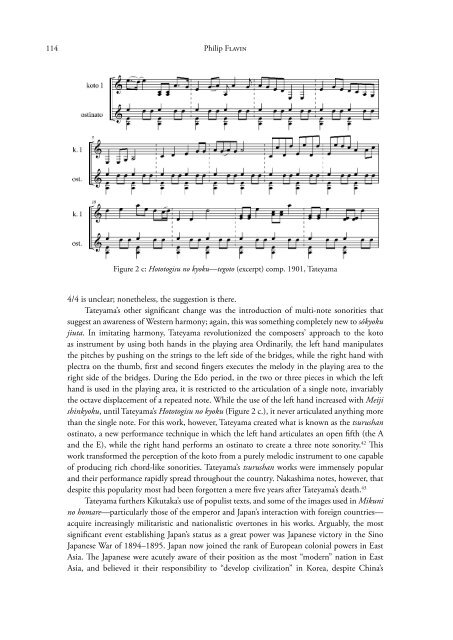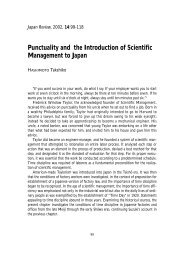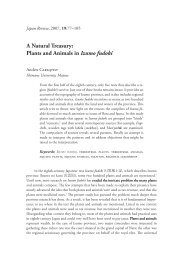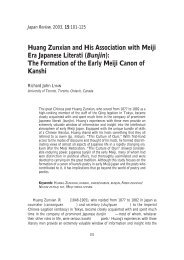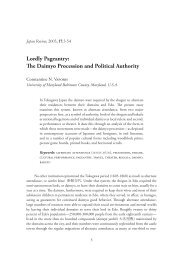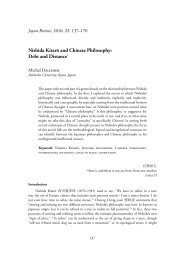Meiji shinkyoku - 国際日本文化研究センター
Meiji shinkyoku - 国際日本文化研究センター
Meiji shinkyoku - 国際日本文化研究センター
Create successful ePaper yourself
Turn your PDF publications into a flip-book with our unique Google optimized e-Paper software.
114 Philip Flavin<br />
Figure 2 c: Hototogisu no kyoku—tegoto (excerpt) comp. 1901, Tateyama<br />
4/4 is unclear; nonetheless, the suggestion is there.<br />
Tateyama’s other signifi cant change was the introduction of multi-note sonorities that<br />
suggest an awareness of Western harmony; again, this was something completely new to sōkyoku<br />
jiuta. In imitating harmony, Tateyama revolutionized the composers’ approach to the koto<br />
as instrument by using both hands in the playing area Ordinarily, the left hand manipulates<br />
the pitches by pushing on the strings to the left side of the bridges, while the right hand with<br />
plectra on the thumb, fi rst and second fi ngers executes the melody in the playing area to the<br />
right side of the bridges. During the Edo period, in the two or three pieces in which the left<br />
hand is used in the playing area, it is restricted to the articulation of a single note, invariably<br />
the octave displacement of a repeated note. While the use of the left hand increased with <strong>Meiji</strong><br />
<strong>shinkyoku</strong>, until Tateyama’s Hototogisu no kyoku (Figure 2 c.), it never articulated anything more<br />
than the single note. For this work, however, Tateyama created what is known as the tsurushan<br />
ostinato, a new performance technique in which the left hand articulates an open fi fth (the A<br />
and the E), while the right hand performs an ostinato to create a three note sonority. 42 Th is<br />
work transformed the perception of the koto from a purely melodic instrument to one capable<br />
of producing rich chord-like sonorities. Tateyama’s tsurushan works were immensely popular<br />
and their performance rapidly spread throughout the country. Nakashima notes, however, that<br />
despite this popularity most had been forgotten a mere fi ve years after Tateyama’s death. 43<br />
Tateyama furthers Kikutaka’s use of populist texts, and some of the images used in Mikuni<br />
no homare—particularly those of the emperor and Japan’s interaction with foreign countries—<br />
acquire increasingly militaristic and nationalistic overtones in his works. Arguably, the most<br />
signifi cant event establishing Japan’s status as a great power was Japanese victory in the Sino<br />
Japanese War of 1894–1895. Japan now joined the rank of European colonial powers in East<br />
Asia. Th e Japanese were acutely aware of their position as the most “modern” nation in East<br />
Asia, and believed it their responsibility to “develop civilization” in Korea, despite China’s


